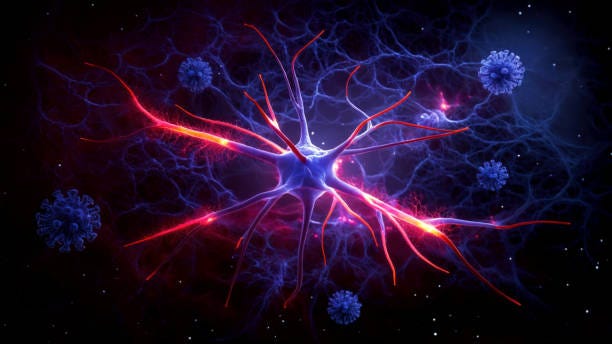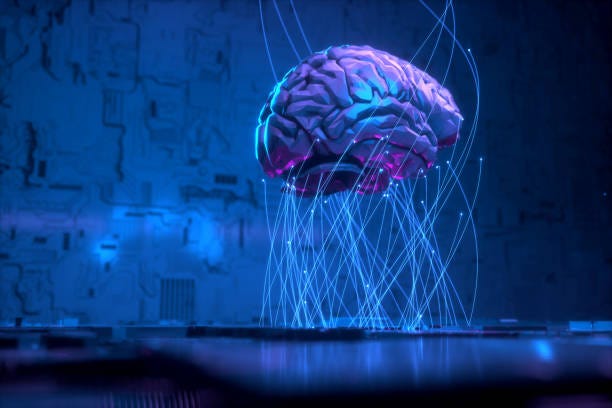Decoding the Mind, Building Smarter Machines: Reshaping Healthcare with NeuroAI
Neuroscience and artificial intelligence (AI) are increasingly intersecting, with each field propelling the other forward. Modern AI algorithms like neural networks were inspired by brain architecture – networks of neurons and synapses – and now these AI systems in turn are helping scientists decipher complex brain data. This two-way exchange has given rise to “NeuroAI,” an emerging field that seeks to make AI more brain-like and to use AI to gain deeper insights into the brain. For example, brain-inspired models have been shown to learn using far less data and power than conventional AI, hinting at more efficient, human-like machine intelligence. By combining machine learning and neuroscience, researchers are achieving breakthroughs that are transforming healthcare, boosting rehabilitation outcomes, and driving innovation in robotics.
Healthcare Applications of Neuro-AI
One major impact of the neuroscience–AI synergy is in healthcare, where AI aids in diagnosing and treating neurological and mental health conditions. AI algorithms can sift through medical images and patient records to detect patterns that physicians might miss. For example, researchers are using machine learning to analyze over a million brain scans linked with health records in order to predict an individual’s risk of developing dementia. In neuro-oncology as well, AI systems can examine MRI and histopathology images to identify brain tumors and suggest optimal treatment strategies faster and with high accuracy.
AI is also enhancing mental health care by enabling more personalized interventions. Machine learning models can integrate data from brain scans, genetics, and behavior to help match patients with the treatments most likely to work for them. A striking recent study used functional MRI and AI to sort depression into six distinct subtypes, or “biotypes,” and predicted which type of therapy each subtype would respond to best. This kind of precision psychiatry could spare patients the painful trial-and-error of finding effective treatment. Similarly, AI-driven analysis of EEG brainwave patterns is improving epilepsy care – algorithms can detect subtle signals that forewarn seizures, allowing early warning or automatic intervention before a seizure strikes.
AI techniques are also being applied to neurological therapies. In the case of brain stimulation treatments like transcranial magnetic stimulation (TMS) for depression, AI-based tools can analyze a patient’s brain activity to predict who will benefit from the therapy. Using EEG data, these models learn neural “signatures” of likely responders, helping clinicians target costly treatments to the right patients. Another emerging approach is closed-loop neurostimulation: implantable devices that monitor brain signals and automatically adjust stimulation for conditions like epilepsy or severe depression, guided by AI algorithms. Though still experimental, these intelligent devices aim to treat disorders more precisely and with fewer side effects.
Rehabilitation Technologies and Neuroprosthetics
Brain-computer interfaces (BCIs) connect the nervous system to computers or prosthetics. Advanced BCIs equipped with neuromorphic decoders can translate brain signals into actions far more efficiently than prior generations. AI-driven BCIs and neuroprosthetic devices are offering new hope for people with paralysis or limb loss. In 2023, researchers demonstrated a brain–spine interface that allowed a man with chronic paralysis to walk again using his own thoughts. They implanted sensors in his motor cortex and stimulators in his spinal cord, and an AI algorithm learned to convert his brain activity into stimulation patterns that move the legs. With training, he regained the ability to stand, walk, and even climb stairs with support – a dramatic example of AI and neuroscience restoring a lost function.
BCIs are also giving a voice to those who cannot speak. In a recent breakthrough, a neural implant combined with a deep learning model decoded a paralyzed woman’s attempted speech in real time, enabling her to communicate at nearly normal speaking speed. Here, AI was key to interpreting the complex neural signals for speech and converting them into audible words. More generally, machine learning excels at recognizing patterns in noisy brain signals. This is crucial for neuroprosthetics: algorithms can infer a user’s intended movement or command from brain or nerve activity, allowing robotic limbs or cursors to be controlled by thought. As these AI models become more adaptive, BCIs continue to improve. Notably, researchers in China recently created a two-way adaptive BCI with a memristor-based neuromorphic chip that learns from both the brain and the user’s feedback, boosting control accuracy and efficiency significantly.
AI is making rehabilitation therapies smarter and more individualized. Robotic exoskeletons and smart prostheses now often include AI software that adjusts assistance in real time based on the patient’s performance. For instance, a learning algorithm can detect when a stroke patient is compensating with incorrect movements during therapy and prompt them (or adjust the robot) to correct their form. Machine learning models have been used to predict patients’ movement intentions and even their likely recovery outcomes, enabling more personalized rehabilitation program. By continuously monitoring motion data and biosignals, an AI-enhanced rehab device can challenge a patient at just the right level – not too easy, not too hard – to maximize recovery.
Brain-Inspired Robotics and Assistive Machines
Engineers have built autonomous drones with neuromorphic vision systems that mimic animal brains, achieving faster and more energy-efficient flight control than standard AI. In tests, this neuromorphic drone’s spiking neural network processed visual data 64× faster and used only a fraction of the power of a GPU. Neuroscience is influencing robotics through brain-inspired algorithms and hardware. The neuromorphic drone developed at Delft University is one example: it uses a special event-based camera and spiking neural network (running on a brain-like chip) to react to its environment in real time. By mirroring how biological neurons communicate (sparingly and asynchronously), the drone can navigate complex environments quickly without heavy computing hardware. Other teams have used brain-inspired reinforcement learning to enable robots to adapt on the fly; for instance, drones trained with neural-network controllers can learn to handle unpredictable wind gusts in real time, significantly improving flight stability. This approach promises robots that are small, agile and smart – closer to the efficiency of insects or birds in flight.
In addition to neuromorphic designs, robotics is drawing on cognitive neuroscience to create machines that interact more naturally with people. Assistive robots in healthcare and caregiving settings are a prime example. These robots use AI to interpret human behavior and emotional states, often informed by neuroscience research on those signals. A current project at University of California Irvine is designing a companion robot for dementia patients that can recognize signs of agitation and then respond to soothe the person or alert caregivers. The robot monitors the patient’s vital signs and facial expressions (their “biodata”) and uses an empathetic response model to help prevent anxiety or dangerous situations like falls. In the future, similar neuro-inspired robots could provide cognitive stimulation, reminders, and assistance for the elderly or patients with neurological disorders, adapting their support based on real-time feedback from the user.
Robotics in medicine is also benefiting from AI and neuroscience integration. In surgery, for instance, robotic systems augmented with AI image analysis can help identify anatomical structures (like brain tumors or critical blood vessels) and guide the surgeon with extreme precision. In physical therapy, rehab robots use neural and physiological sensors to adjust exercises to the patient’s comfort and progress. All of these advances rely on AI algorithms that learn from data – whether it’s the layout of a hospital room or the muscle signals of a patient – and many of those algorithms are inspired by how the brain learns and adapts. The result is more adaptive, human-aware robots.
Challenges and Future Directions
While the fusion of neuroscience and AI is yielding powerful technologies, it also presents challenges. Ensuring safety, transparency, and fairness of these systems is paramount. Black-box AI models can be problematic in healthcare – for example, a model that flags a brain scan abnormality should ideally explain what it found. Researchers are calling for more interpretable AI in critical applications, so that clinicians and patients can trust the results. Another challenge is generalization: AI systems trained on one dataset or population may perform poorly on others. For neuro-AI tools to be reliable, they must be tested and tuned across diverse demographics and conditions. Data privacy is also a concern, particularly with neural data from brain implants or wearables. Strict safeguards and ethical guidelines are needed to protect sensitive information about people’s brains and mental states. Indeed, some researchers have advocated for explicit “neurorights” – measures to protect cognitive privacy and individual autonomy – given the potential of neuro-AI to intrude on the most private aspects of the mind.
Despite these hurdles, the coming years look promising. Neuroscience and AI are poised to continue an accelerating feedback loop. Advances in brain research – such as detailed neural maps and a better understanding of cognition – will inform new algorithms that could make AI even more efficient and general-purpose. Conversely, next-generation AI will enable neuroscientists to glean insights from massive datasets of neural activity that were previously indecipherable. We may also see the rise of digital twin brain models – detailed simulations of an individual’s brain that are continually updated with real-world data – to predict disease progression or test therapies virtually before trying them in patients. In practical terms, we can expect to see more AI-driven neurotech reaching patients. Brain-computer interfaces will likely become less invasive (using noninvasive sensors with AI decoding) and more adaptive, thanks to machine learning that can calibrate devices on the fly for each user. Neuro-inspired computing hardware is also on the horizon, which could bring brain-level energy efficiency to everyday AI applications. Ultimately, the fusion of AI and neuroscience aims to enhance human well-being – from predictive tools that catch neurological illness early, to personalized treatments for mental health, to assistive robots that improve quality of life. By surmounting current challenges through interdisciplinary collaboration, the field is moving toward a future where technology and neuroscience work hand-in-hand to heal, rehabilitate, and augment human capabilities. In essence, the ongoing marriage of AI and neuroscience stands to usher in an era of unprecedented medical capabilities and human-machine synergy – one where neurological disorders are more preventable, recoveries more complete, and intelligent assistants enhance our lives while honoring our autonomy.
Connect & Learn More
Continue the conversation on LinkedIn: https://www.linkedin.com/in/zenkoh/
Subscribe for in-depth insights:
Legal Disclaimer
This article is intended for informational purposes only and does not constitute professional advice. The content is based on publicly available information and should not be used as a basis for investment, business, or strategic decisions. Readers are encouraged to conduct their own research and consult with professionals before making decisions. The author and publisher disclaim any liability for actions taken based on the content of this article.









